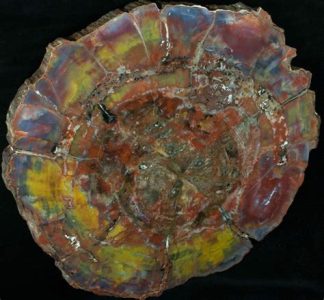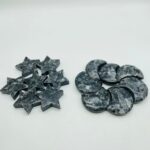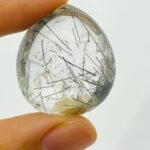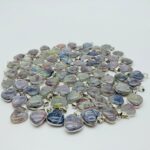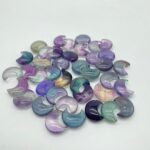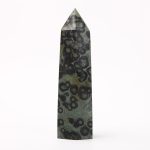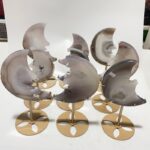Introduction
Clear crystals, renowned for their exceptional clarity and transparency, have captivated humanity throughout history. Their allure stems from their invaluable properties and broad range of applications. This article presents an in-depth exploration of clear crystals, comparing them to other materials and highlighting their unique characteristics.

Physical Properties
Clarity and Transparency: Clear crystals exhibit unparalleled clarity and transparency. They allow light to pass through them with minimal distortion, providing a clear and unobstructed view.
Refractive Index: The refractive index of clear crystals plays a crucial role in their optical properties. A higher refractive index causes light to bend more when passing through the crystal, resulting in brilliance and dispersion of colors.
Hardness: Clear crystals vary in hardness, with some being extremely hard and others relatively soft. Hardness determines their resistance to scratching and damage.
Optical Properties
Birefringence: Birefringence refers to the splitting of light into two rays when passing through a crystal. This property is essential in optics and is utilized in devices such as polarizers and optical filters.
Polarization: Clear crystals exhibit polarization properties. Light passing through them is polarized, meaning it oscillates in a specific direction. This property finds applications in photography, LCD displays, and spectroscopy.
Types of Clear Crystals
Natural Crystals: Clear crystals occur naturally in various forms, including quartz, calcite, and selenite. These crystals vary in size, shape, and optical properties.
Synthetic Crystals: Synthetic clear crystals are produced in laboratories under controlled conditions. They are identical to their natural counterparts in terms of physical and optical properties but may offer greater uniformity and purity.
Applications
Clear crystals have found widespread applications across various industries, including:
Optics: Lenses, prisms, and optical fibers utilize clear crystals due to their exceptional optical properties.
Electronics: Piezoelectric sensors and actuators employ clear crystals for their ability to convert electrical energy into mechanical vibration and vice versa.
Jewelry: Gemstone-quality clear crystals, such as diamonds and sapphires, are highly prized for their beauty and durability.
Clear Crystals VS Other Materials
| Property | Clear Crystal | Glass | Polymer |
|---|---|---|---|
| Clarity | Excellent | Good | Varies |
| Transparency | High | Moderate | Low |
| Refractive Index | 1.5-2.5 | 1.3-1.4 | 1.2-1.7 |
| Hardness | Varies | 5-7 Mohs | 1-3 Mohs |
| Birefringence | Yes | No | No |
| Polarization | Yes | No | No |
| Applications | Optics, Electronics, Jewelry | Windows, Containers | Packaging, Insulation |
Unique Characteristics
Beyond their common properties, clear crystals possess several unique characteristics that distinguish them from other materials:
Tunability: Clear crystals can be tuned to specific optical properties by altering their composition or structure. This tunability enables precise control over their optical performance.
Pyroelectricity: Some clear crystals exhibit pyroelectricity, the ability to generate an electric charge when subjected to temperature changes. This property finds applications in sensors and energy harvesting.
Tips and Tricks for Working with Clear Crystals
- Handle with care: Clear crystals can be fragile and should be handled with care to avoid damage.
- Clean regularly: Keep clear crystals clean to maintain their optical performance.
- Avoid exposure to extreme temperatures: Sudden temperature changes can stress clear crystals and lead to cracking or discoloration.
- Use proper tools: Specialized tools are required for cutting and polishing clear crystals.
Common Mistakes to Avoid
- Using abrasive cleaners: Abrasive cleaners can scratch the surface of clear crystals.
- Overexposure to sunlight: Prolonged exposure to sunlight can damage clear crystals, causing discoloration or yellowing.
- Mishandling: Improper handling can lead to chips, cracks, or breakage.
Step-by-Step Approach for Working with Clear Crystals
- Select the appropriate crystal: Consider the desired optical properties and applications when choosing a clear crystal.
- Prepare the crystal: Clean the crystal thoroughly and ensure it is free from defects.
- Work carefully: Use proper tools and techniques to handle the crystal without damaging it.
- Finish the crystal: Polish or coat the crystal as required to achieve the desired finish.
Why Clear Crystals Matter
Clear crystals play a vital role in various technologies and applications. Their exceptional optical properties enable the development of advanced optical devices, sensors, and energy-efficient materials. By understanding and harnessing their capabilities, we can unlock new possibilities in fields such as optics, electronics, and energy.
Current Status and Future Direction
Clear crystals continue to be an active area of research and development. Ongoing efforts focus on developing new methods for synthesizing and tuning clear crystals with tailored properties. The future holds exciting prospects for the advancement of clear crystal technologies, leading to novel applications and innovations.
Conclusion
Clear crystals, characterized by their exceptional clarity, transparency, and optical properties, hold immense significance across numerous industries. Their unique characteristics, coupled with their tunability and diverse applications, make them essential for various technologies. By embracing the power of clear crystals, we can unlock a wide range of possibilities and drive advancements in optics, electronics, and beyond.







